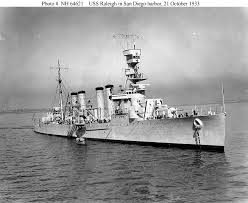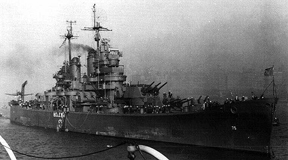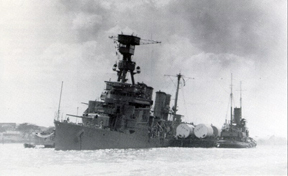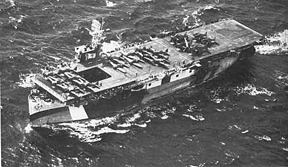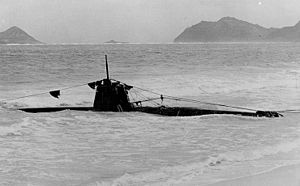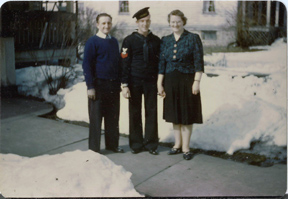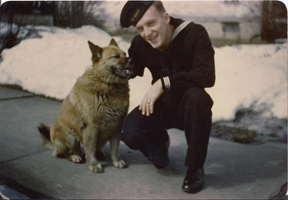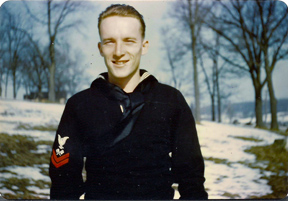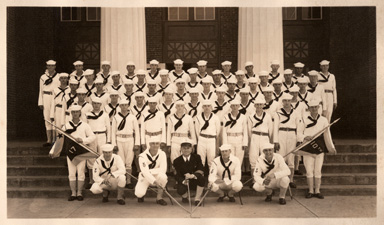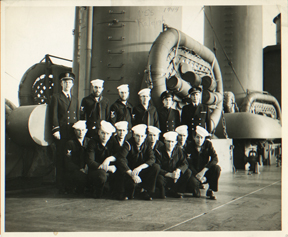Sunday, December 7, 1941: I was on shore leave from my ship the USS Raleigh, stationed at Pearl Harbor, Hawaii. A group of us guys had rented a little cottage in Pearl and we spent the night playing poker and drinking. Very early in the morning I had gone out and gotten some cheese and crackers for our breakfast. It was quiet and peaceful and beautiful as always in that tropical paradise. We were sitting around eating and barely functioning cognitively when some guy came in and said, "You guys in the Navy?" That was pretty obvious. Although most of us were sitting in our skivvies and I was wearing civilian clothes, we had whites hanging on the wall. We said sure we are and he said, "You better get back to base - the Japanese are attacking!" We didn't believe him. We could hear the airplanes, but that wasn't unusual, you always hear airplanes. You could hear bombs, but we thought it was the Coast Guard running artillery practice. They would fly every Sunday. The Navy didn't go to sea on Sundays so it wouldn't interfere with their practice. Well, the guy kept talking and talking and it finally convinced some of us. I guess it convinced me because I went outside and looked up and there were the airplanes, flying pretty close, with red meatballs on their wings. Now we believed. We packed up our gear quickly and headed over to the YMCA where my uniform was stowed in a locker. When we arrived there we knew something was wrong because there wasn't anybody there and on a Sunday morning that was probably the most popular place on the island. Usually there was a mob of guys there. I went in and changed clothes. The other two guys already had their uniforms on and when I came out they had disappeared. I don't know where they went to. I knew something was going on and I had to get back to my ship as fast as I could. There was a bus outside waiting and I still remember I had to pay a quarter to get back to base. Good thing I had change. There were four lanes of traffic out to Pearl Harbor, with two lanes in each direction. The military had taken over all four lanes, with three lanes directed to Pearl Harbor, Hickam Air Field, and the other bases, and the last lane was for pilots trying to get back to their airplanes. They didn't know there weren't any planes left to get back to.
All we thought of was getting back to the Raleigh and joining the fight. We didn't know it, but the attack was over and the Japanese had left. Right behind the Raleigh we saw the USS Utah, an old beat-up battleship used as a target ship. It had been hit by one torpedo, rolled over, and just kept on going, 85 bodies still in that ship. We came alongside the Raleigh and just stepped from the launch into the ship it was so low in the water. Of course I went to the bridge first, because that's where people are suppose to be during the battle stations. We couldn't get any radio station that wasn't a jumbled mess. We knew the Japanese had attacked us, but nobody really knew what was going on. Not out there. I'm convinced that Franklin Roosevelt knew we were going to be attacked, or if he didn't' know he had a real suspicion. I think he wanted us to get into the war so we could be on the side of the British. Because there was a real strong group in the North East that wanted to go in on the side of the Germans, neo-Nazis, which was an organization of American Germans. There were a lot of Congressmen who wanted to be on the side of Germany. planes were hoisted out by hand power alone. Both torpedo tubes, both catapults, and the steel cargo boom were all disconnected and jettisoned by hand power. Both anchors were let go.Then the second wave hit and there were many near misses falling about the ship and only one bomb hit. The bomb had come down through the deck over head of the carpentry shop, through the bulkhead of the carpentry shop, through the deck of the garbage deck, through the living compartment where my locker was, into the shaft alley, then through the bottom of the hull and then blew up. It passed very close to two large tanks containing 3,000 gallons of high-test aviation gasoline. It didn't explode in the ship because it was an armor piercer and they're built to go through steel for a long ways. The left a great big hole forward and aft and it filled with water and oil. Ironically, the bomb was made from one of our old projectiles we'd sold as scrap metal. Water came through an eight-inch hole pretty fast. It would flood on one level on one side and then on the other side. The ship was flip flopping back and forth, with oil coming in. She sunk down by the stern, sinking down level with her after-deck. The crew had immediately gone to battle stations and later in the battle report was credited with five planes shot down. After the attack and during the night of December 7th the ship would continue to list from side to side. Crew was very busy, not knowing what was going to happen next and continually working to control the ship's balance. People were still at battle stations all the time until late in the night, with some minor chances of getting sleep a few people at a time. I slept on the bridge for three days. I couldn't sleep in my bunk because it was full of oil. We had to man all the guns, even though they were outdated and had to be hand loaded. The foremost gun was 160- feet in the air and ammunition had to be carried up a vertical ladder by hand. Now our ship stability wasn't bad, but the bomb caused oil and salt water to come into the shaft alley. While everyone else was still manning the guns, our first lieutenant, Fritz Kline, and his repair parties put extra lines out to these keys to kind of tie us tight, so we'd quit this flip flopping back and forth. They also counter-flooded. See, damage control in those days was not an exact science. People knew certain things about ships: about what would happen when heavy winds hit them or heavy seas or ice and things like that. But they didn't' have the expertise that damage control has now. Damage control on a carrier, for instance, is one of the most import jobs on the ship. It's tremendous. You've got a monster of 3,000 or 4,000 compartments, you've got hundreds of thousands of feet of cable wire, you've got a couple thousand doors, and you've got all those damn airplanes up there with aviation fuel tanks. By god, oxygen systems that will burn and you've got all these other gases that they use for aircraft of different types or for cleaning or whatever. We lost a lot of ships through accidents, but if you can keep the ship afloat for an about is what the hell is my job, what have I got to do. You're trained so you should automatically do it. That's why we train people. Sometimes they don't do it. Sometimes you have new men that haven't been trained enough. Sometimes they just panic.Ever so often in those early days after the attack somebody would test fire a gun (they'd put guns all over the place by then) and always somebody had itchy fingers. Half the time after one shot, everybody else would fire. We had four airplanes coming in from our carriers at sea after dark and all it took was one machine gun and everybody started shooting and shot down all four of our own planes. It was dark and you couldn't really tell whose planes they were. Either they were test firing a gun or somebody got scared. One of the four pilots got out alive, but the others were all killed. This is what fright does to you. We were in this condition for weeks, but there were no more attacks.
A crew was sent over to the capsized Utah on Monday to cut out any men in the hull. Big ships have an inner deck around the hull that's way down under the water that's usually empty. It doesn't even have fuel oil. They call them the double bottoms. This guy was the ship engineer and he couldn't get out of the ship, but he was down there with some oxygen so was able to work his way into the double bottoms. I guess he found a wretch. We heard these tappings in there and they got torches and cut it open. They could tap and he could answer and they figured out where he was. He was in pretty bad shape. .
We still didn't know if the war was over or whether we were going to keep fighting or what. Hell, we didn't know anything really, most people. And periodically some jerk on a machine gun somewhere would test fire it and if one guy test fired somebody else had to test fire his and by god, soon you have machine guns going off all over. Course you can't blame them. These guys were pretty nervous and scared. It took about three days to pump out the water and oil from our ship. I finally got to my locker and saw my blues looking all shiny like new. I pulled them out and they were covered with oil. Everything was covered. I rescued a ten dollar bill and two ones soaked in oil. I probably should have kept them, but I washed the bills as best I could and later took them to the bank and cashed them in. Later we got pontoons along side and stabilized the ship. Then they sent divers to patch the bomb hole. The couldn't do anything with the torpedo hole, it was just too big. Before Christmas they got the Pennsylvania out of dry dock and the Downes. They put us in place of the Pennsylvania and took the pontoons off and set us down on blocks and pumped us dry. It was the third Christmas in a row we had spent in the same spot. I didn't get to shore for three weeks. My mom didn't know if I was alive or dead, but finally I got a message to her. By then the Navy had started censorship. They had to read everyone's letters to make sure we didn't tell where we were, where we were going, or what we were doing. But at least they knew I was alive. In February of 1942 we left Pearl Harbor and sailed to Mare Island in Vallejo, California, for repairs. We had to wait four months for directions from Washington, which is longer than it should have been, but in one way I was lucky. It gave me the chance to get back home and get married. My four year enlistment was up and they weren't letting anybody go so I extended for two years which gave me a nice piece of travel money. Agnes and I married in Penn Yan, NY, in May. We drove across the country as a honeymoon and settled in San Francisco where Agnes settled in to wait again. I went back to the war. Frank's Photo Album
|

